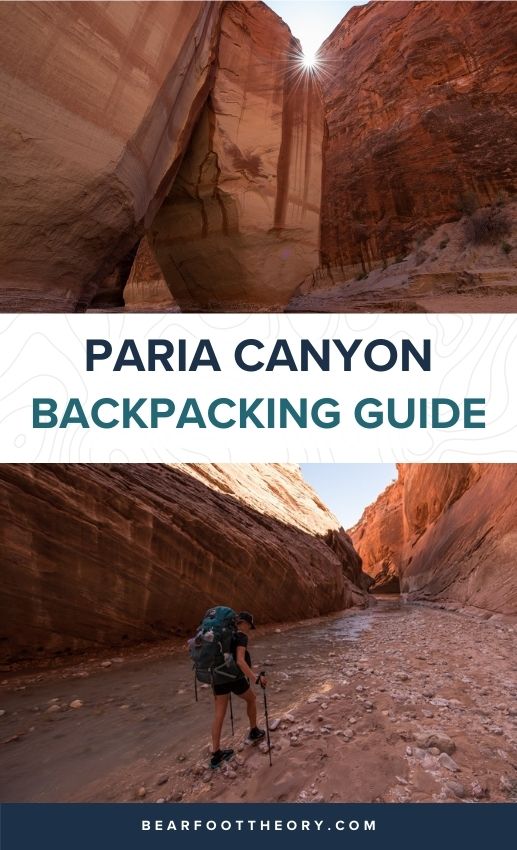Paria Canyon Backpacking Guide
This is hands down my favorite backpacking trip in Southern Utah. Get the full details on hiking through Paria Canyon here.

Located on the Utah/Arizona border in the Paria Canyon-Vermillion Cliffs Wilderness, backpacking Paria Canyon involves 38 miles of hiking down the meandering riverbed in between two enormous walls of Navajo sandstone.
I’ve done this backpacking trip twice now – spending four days hiking through this winding, peaceful canyon, and in my opinion, Paria Canyon has the best of what Utah has to offer.
A Paria Canyon backpacking trip requires wading downriver, with dozens of crossings – in some ways similar to hiking the Narrows in Zion, but more remote and isolated. Your feet will be wet the entire time. Due to the nature of the trail (or lack of trail), the hiking is slow, but it is nothing short of spectacular and worth every ounce of effort.
What made it even better is that this trail is very quiet. The first time I hiked it, we only saw one other pair of hikers. The second time, we only saw a few small groups on the first and last day. Both times, we had the canyon all to ourselves, meaning that the BLM’s permit process is working well to keep this place wild.
In this Paria Canyon Backpacking Guide, I share everything you need to know to plan your own backpacking trip.
This post may contain affiliate links.
Paria Canyon Hike Overview
Trail Basics
My Route
While there are three different starting trailheads for Paria Canyon, the best way to experience it is a one-way hike from the White House Trailhead near the Paria Contact Station and finish at Lee’s Ferry. This is the route I followed on both of my trips.
This route is 38 miles long and gradually loses 1,600 feet in elevation over the course of the trip. The trail is mostly easy to follow, as a majority of the hiking is done in the riverbed.
Both times, I did the Paria Canyon hike in 4 days/3 nights and found the pace to be just right. It honestly would have been difficult to do it in less. We met one couple doing it in 3 days/2 nights. If that is all the time you have, then it is doable, but be prepared for very long days. It’s important to keep in mind that hiking in the river is surprisingly slow, especially if water levels are high.
My most recent trip was in late September when the days were shorter. We woke up at 6:30am each day and hiked at a leisurely pace until about 4:30pm. That gave us 2 hours until sunset to set up and enjoy camp.
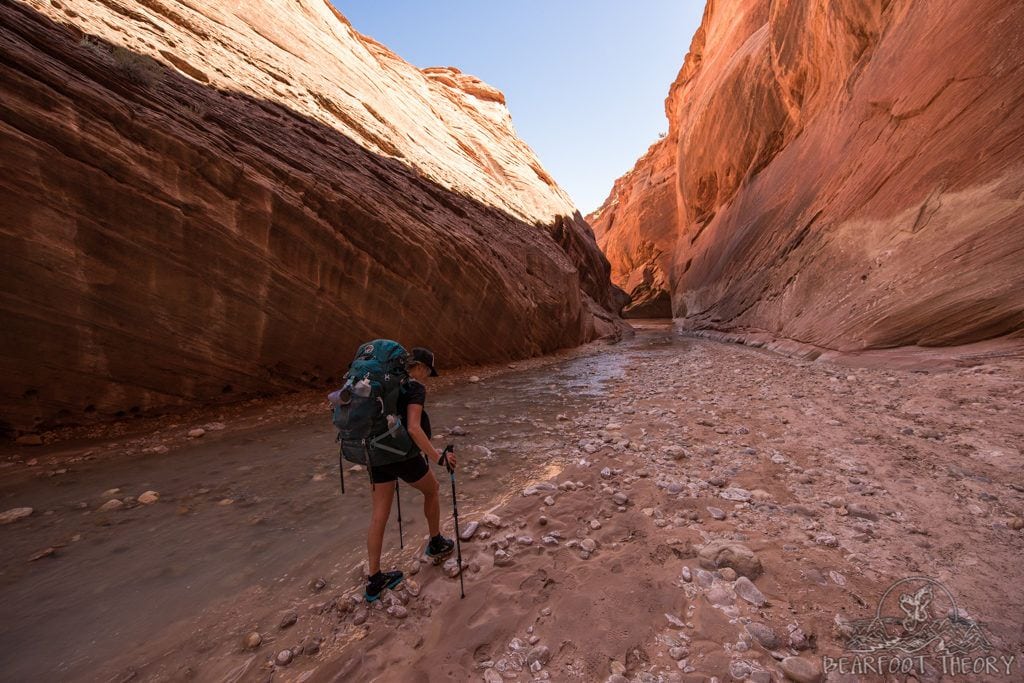
Alternative Routes
There are a few alternative routes you might consider, depending on how much time you have and what kind of challenge you are looking for:
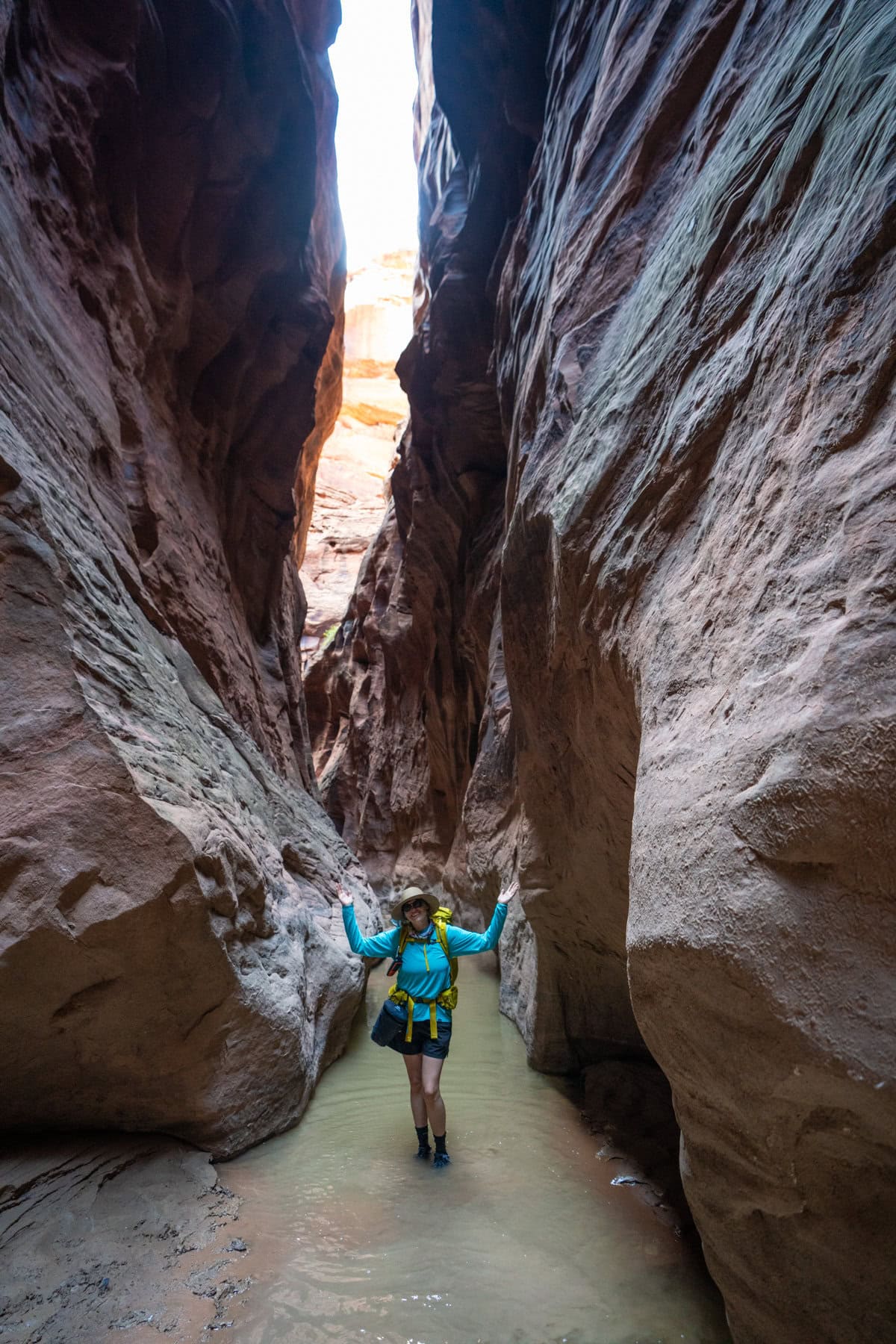
If you want to start at White House like I did, you can travel through the Paria Narrows and then still explore a bit of the bottom of Buckskin Gulch once you reach the Confluence on Day 1. While not as constricted as Buckskin Gulch, the walls of the Paria Narrows close in to about 6 feet across at some points, meaning you still get to experience some deep slot canyon hiking.
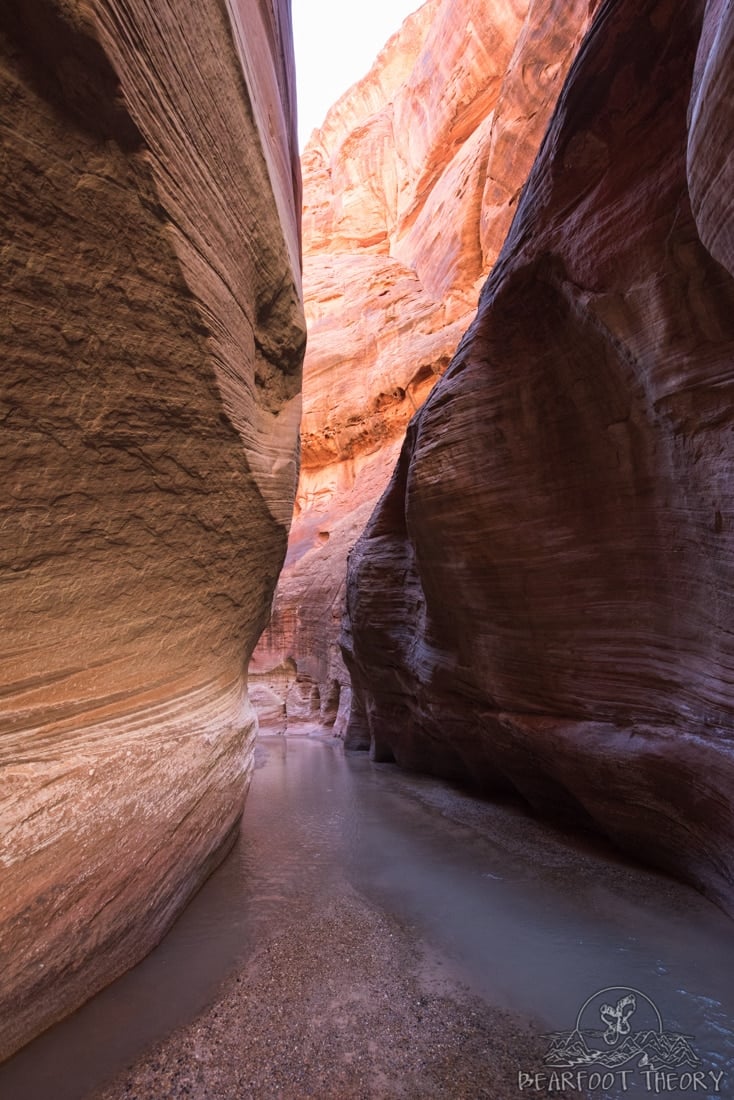
Save this post!
Enter your email & I'll send this post to your inbox! You'll also receive my weekly newsletter full of helpful advice for planning your adventures.
Paria Canyon Map and Navigation
This is the map the ranger will provide you when you pick up your permit at the Paria Contact Station. You can click on it to view a magnified version. As you can see, it’s not very detailed, and they had no other maps available for sale.
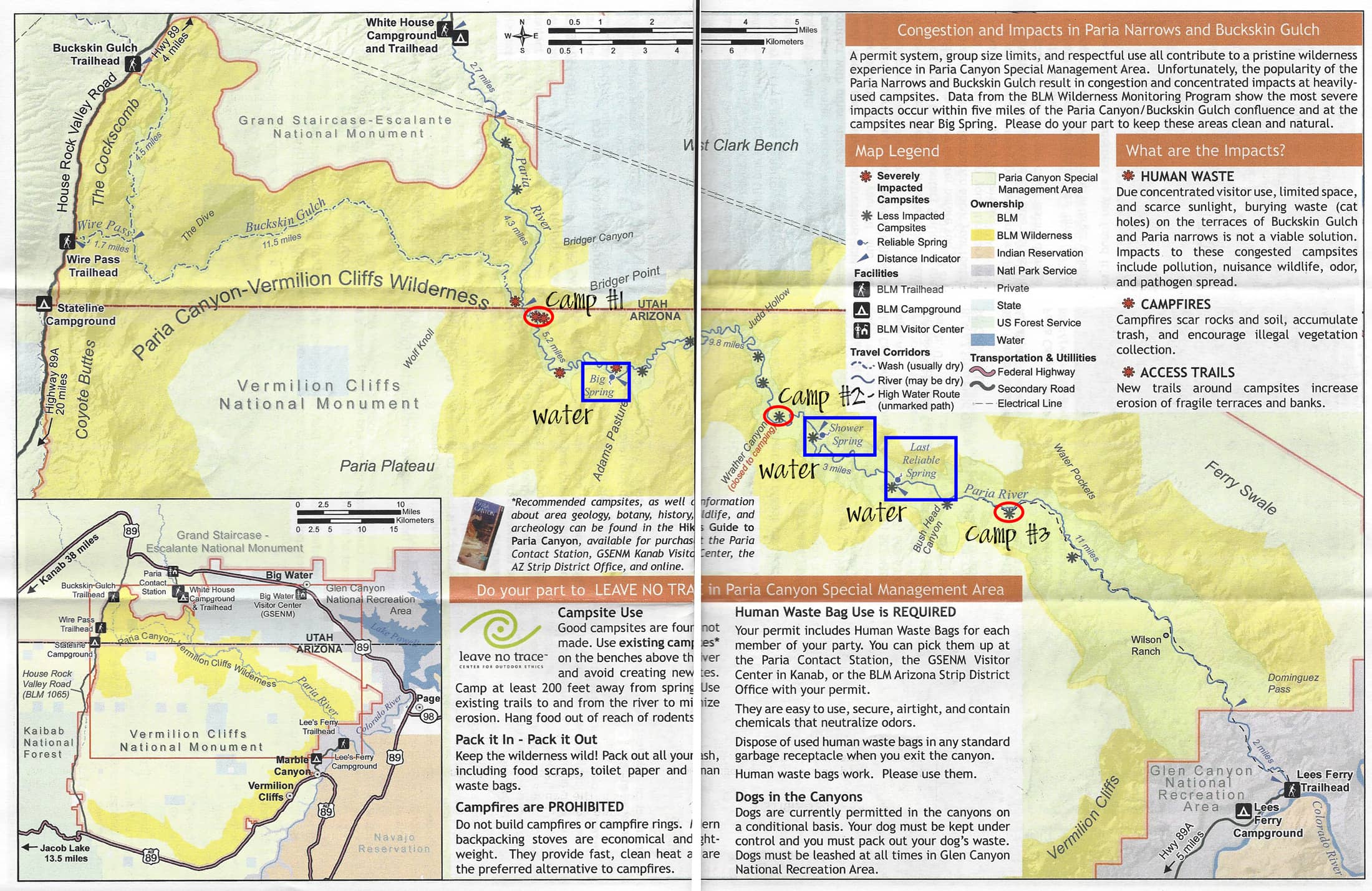
While navigation through Paria Canyon is easy (it’s impossible to get lost), there are very few reference points that can help you determine your location. For this reason, I highly recommend you carry a GPS on your trip.
To help you, I created a GPS file with the location of the campsites and springs, so you can track your location in real-time on the hike. Download my GPS file here. Just click “Export” and choose GPX, and then you can upload that file to your GPS.
If you don’t have a GPS already, I use the Garmin Inreach which is also acts as an emergency satellite communicator.
Best Time to Hike Paria Canyon
Although the canyon is open year-round for backpacking, the air temperatures in late spring and early fall are going to be the most comfortable. These are also the most popular times, so you need to plan far in advance to make sure you get a permit through the lottery system.
The risk of flash floods is the highest in July, August, and early September. Flash floods in Paria Canyon, particularly in the Narrows, can be very dangerous since there are places where there is no high ground.
In the days leading up to your trip, be sure to check Paria Canyon weather, as well as the weather at Bryce Canyon since rain in Bryce Canyon flows down into the Paria watershed. If the forecast is calling for a chance of rain, call the Rangers station to seek their advice about whether or not it is safe to hike.
Even after dry periods, the river banks can be very muddy and slippery. For this reason, I probably wouldn’t do this hike right after a lot of heavy rain. Recent storms mean that the river will be deep, extra muddy, and too silty to filter from.
Paria Canyon Permits
Permits are required for both day hiking and overnight trips in Paria Canyon and Buckskin Gulch. Walk-up permits are available for day hiking at the trailheads (no limit on day hikers – $6 fee), but overnight permits must be obtained through the Paria Canyon online permit application system.
No same-day overnight permits are granted. Permits must be picked up within 10 days of your start date from the Vermillion Cliffs National Monument office in Saint George, the Paria Contact Station, which is right near the White House Trailhead, or the Kanab BLM field office.
The BLM only allows a total of 20 people per day to enter the canyon on overnight permits, and that is across all of the trailheads. There is a $6 reservation fee per group, and an additional $5 permit fee per person per day. Dogs are also allowed for an extra fee of $5 per dog per day. When making a reservation, you will reserve the number of days you plan to spend in the canyon, not nights.
For overnight permits, the reservation system opens up at 12pm Mountain Time on the 1st of every month, 3 months before the month of your hike. For example, on February 1 permits for May would open.
On the permit application website, the calendar shows you when there is availability. If a date is blue, it means there are permits available to enter the canyon to backpack on that day, and the number shown indicates the number of spaces (one space = one person) that are available. Gray dates mean there are no permits available to start on that day.
For the best chance of getting a permit for the busiest spring and fall months, you should plan on being on the website right at noon on the day that permits become available.
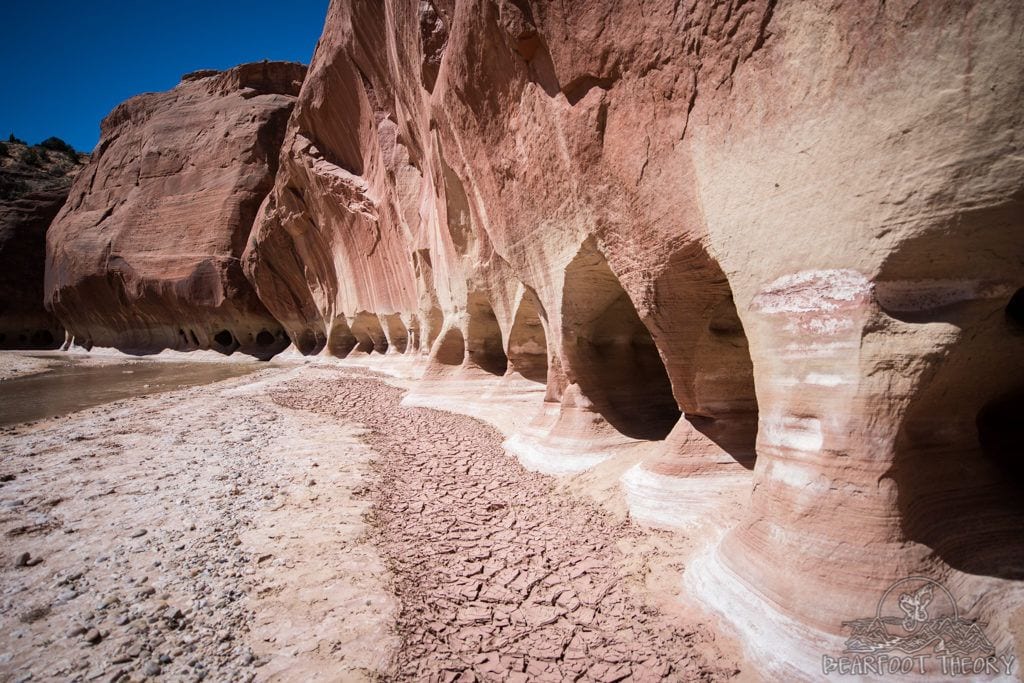
Paria Canyon Trail Campsites
Campsites are spread throughout Paria Canyon and tend to be on sandy beaches above the river. The BLM asks that you choose existing campsites that are at least 200ft away from water and also appear to be worn to avoid creating new sites.
It was pretty obvious where most of these campsites were, and you can see the three campsites I stayed at on my first trip marked on the map above. The main thing to take into consideration when camping is the location of the fresh water springs. Depending on how much sediment is in the river, the springs may be the easiest places to obtain water.
You will need to filter your water even from the springs, so be sure to bring a backpacking water filter. Campfires are not allowed at any of the sites.
Based on my two trips, my recommendations for campsites are:
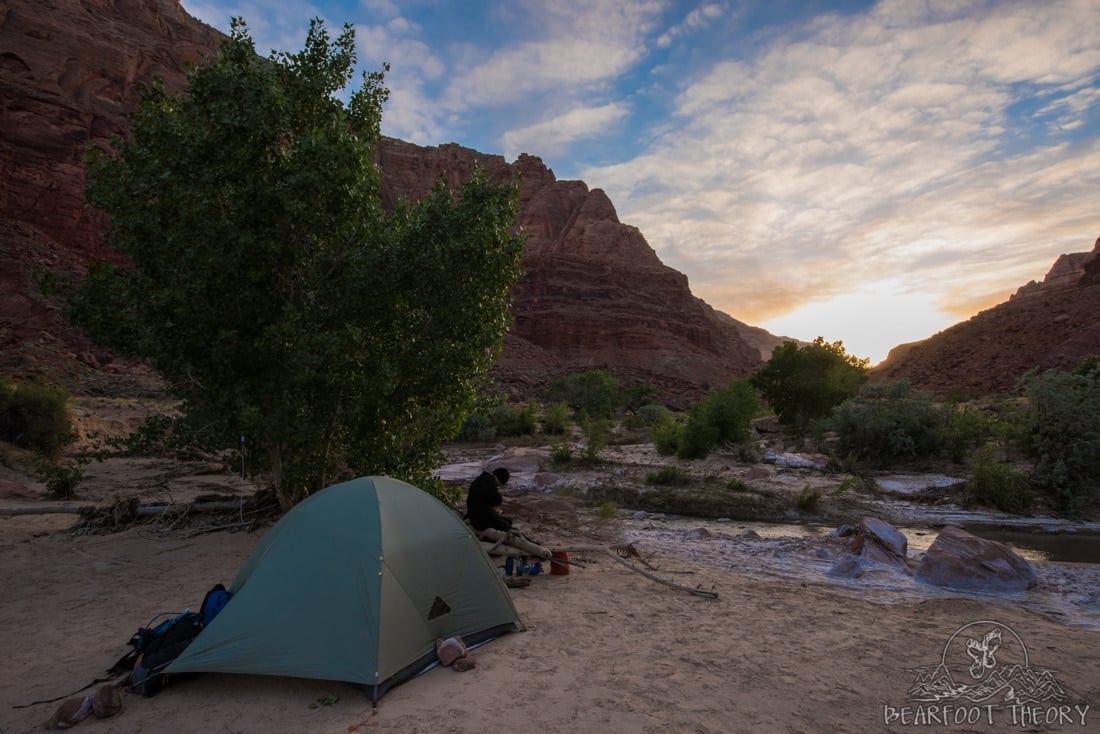
Water Availability in Paria Canyon
Water availability is something to take into account when you are planning your Paria Canyon backpacking itinerary, which might seem strange considering you are hiking down a river.
Filtering from the river
The Paria River can be very silty, and a lot of water filters simply can’t handle the grit and can get clogged. However, I lucked out on both of my trips. It hadn’t rained for a while, and the water flowing in the river was relatively clear. This meant we were able to filter right out of the river without any issues.
Due to animals that live upstream, I’ve heard that if you are going to drink water out of the river, you should both filter and purify it to get rid of bacteria and viruses. We only filtered water and didn’t use a purifier, and neither of us got sick, but if the water had looked dirtier or there had been a lot of recent rain, I would have thrown some purification tablets in just in case.
For filtering: I used the CNOC Outdoors 2 liter water container to fill from the river and then ran the water through my Versa Flow Lightweight water filter into my Platypus Soft Bottles. This system is incredibly light, was very fast, and is easy to backflow if it happens to get clogged (which I did not experience).
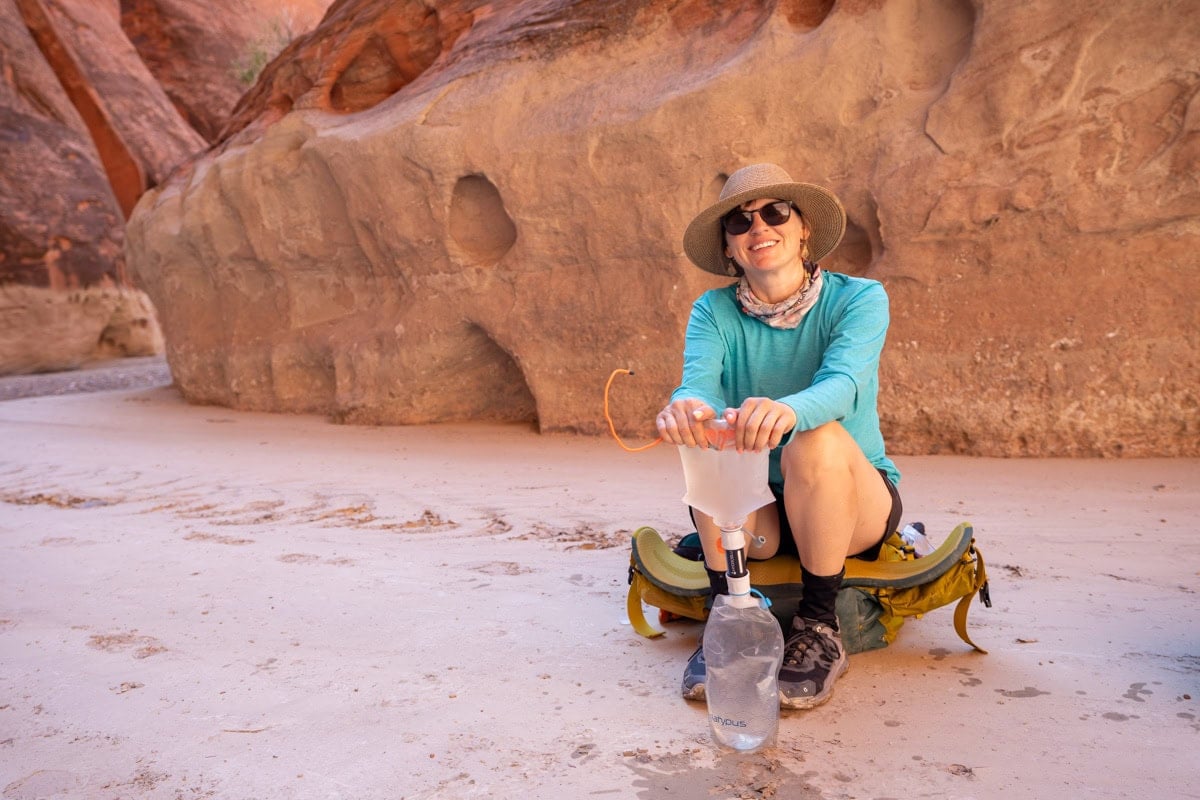
If there is lots of sediment in the river, there are a couple of tricks you can use to prevent your filter from getting clogged. First, you can use a buff, bandana or shirt to pre-filter the water. Next, you can let the water and silt settle in some sort of container before running the water through your filter. You can also bring something called Alum Powder which can be a life saver in the desert. You just add a small amount of alum to the water, and it causes the silt to quickly sink to the bottom. Once that happens, you can carefully pour the clear water into whatever you are using to treat/filter it.
Filling up at the springs
If the river is really silty, your best bet is going to be to fill up at the reliable freshwater springs that provide a source of drinking water. These are seeps where the water flows right out of the cracks in the sides of the canyon walls. This water should also be filtered for safety, but the sediment won’t be an issue.
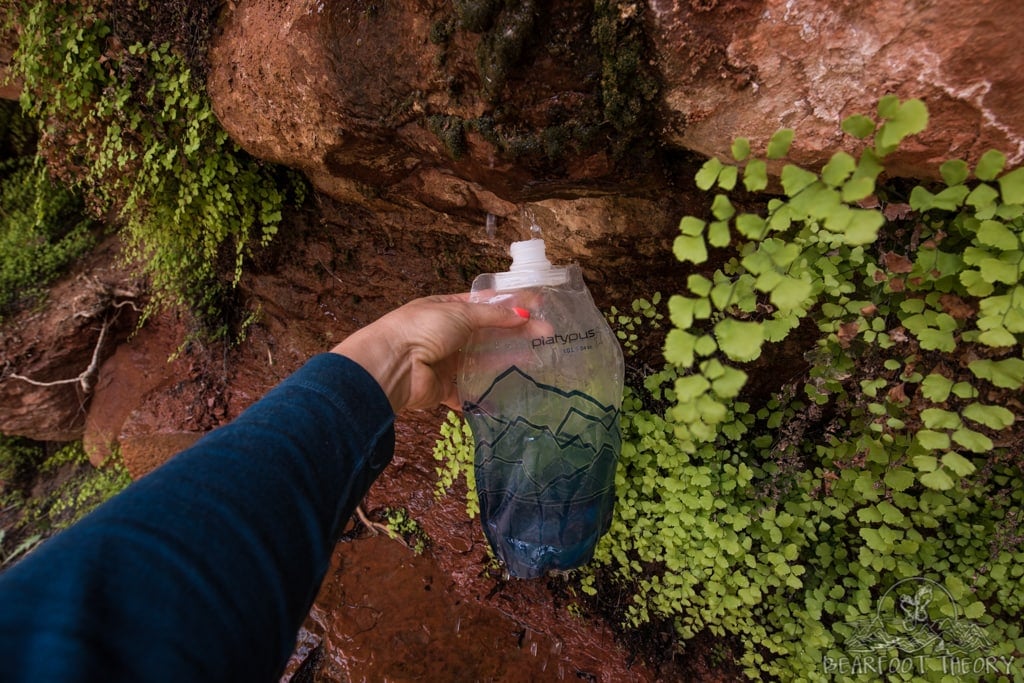
Many of the springs are easy to miss, so it’s important to be on the close lookout. Lush vegetation growing out of the canyon walls is a sign that a spring might be present.
The most reliable springs are marked on the map above (and on the GPS file) and are located at:
Please note water access may have changed since I was there – always check with a ranger before heading out for the most up-to-date water information.
If you can’t easily filter from the river, camping at sites near these springs is best because it means you don’t have to carry additional water for cooking your backpacking meals. You just fill up when you arrive at camp and before you leave in the morning. In this case, I’d recommend carrying at least 4-5 liters per person to get you from one spring to the next.
It should be noted that you should fill up all of your water bottles at the Last Reliable Spring. Beyond that, the trail has virtually no shade and can be very hot.
Paria Canyon Backpacking
Trip Report
Day 1
From the White House Trailhead, the canyon walls start out short and wide and slowly narrow as you continue hiking down the river. The first part of the hike can be quite hot as there is little shade so if you are hiking in the warmer months, make sure to get an early start.
Around mile 4, you reach the entrance to the Paria Narrows. The towering sandstone walls in this section reach up to 800 feet high and at some points, the walls are a mere 6 feet apart. In this section it is cooler and shadier, and some places in the Narrows, the water can become waist deep following rainfall.
During my first trip, the water was never more than knee deep in the Paria Narrows. On my second trip however, the Narrows were bone dry. We didn’t find any water until right before the confluence.
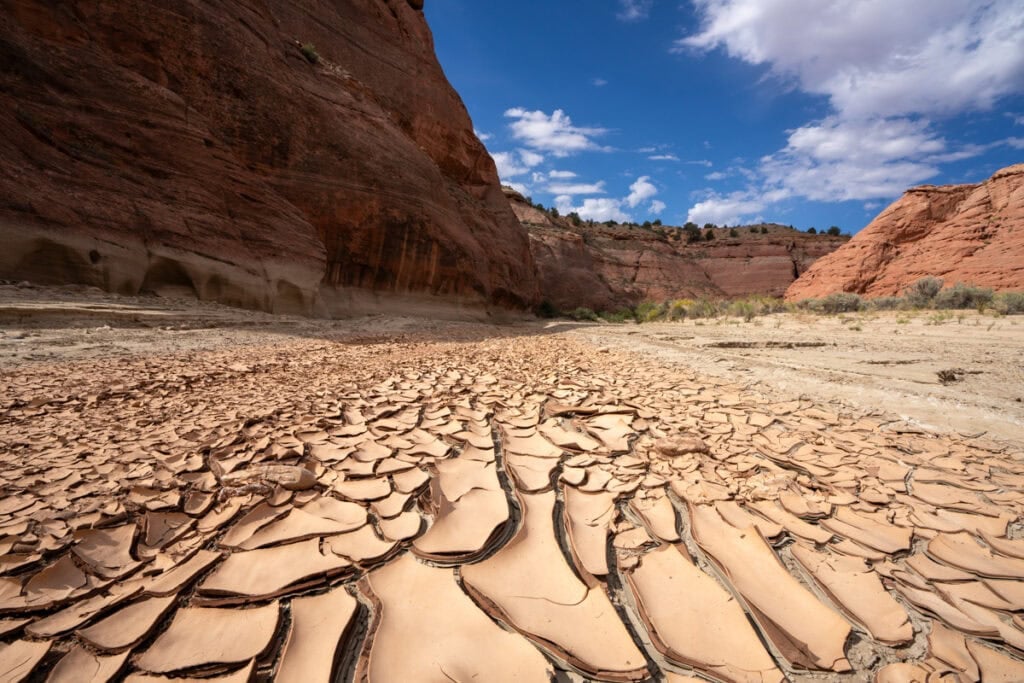
Keep in mind it is hard for the rangers to predict current water levels, so you should be mentally and physically prepared for either scenario.
At mile 6.7, you reach Slide Rock Arch – an enormous boulder that once fell into the canyon and has formed a short tunnel. If you catch it at the right time in the afternoon, the sun beams down creating some great photo opportunities.
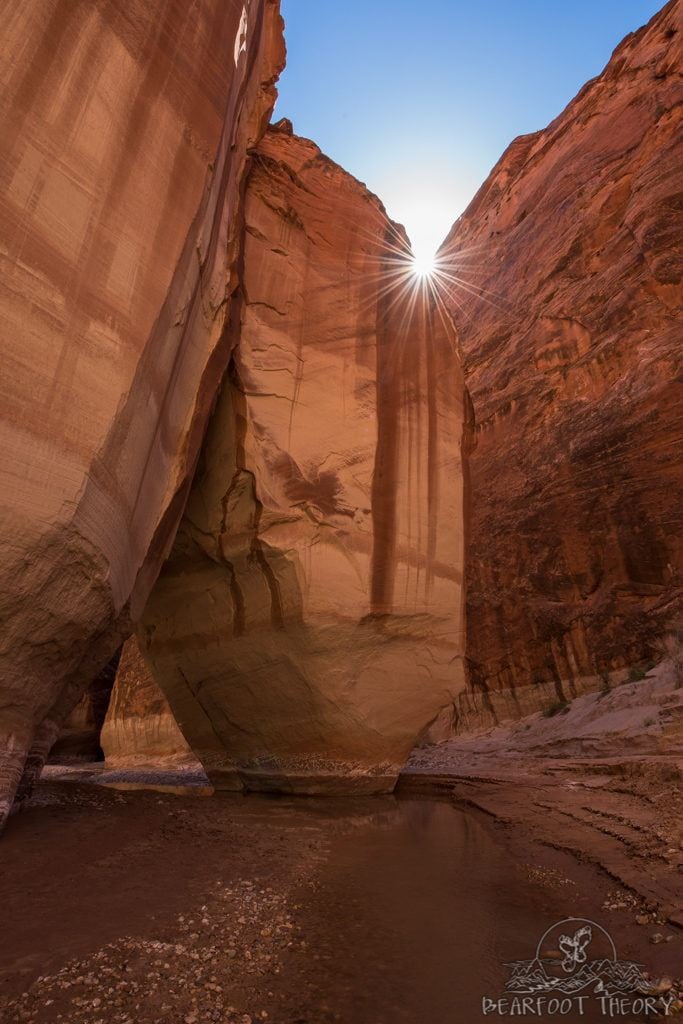
Around mile 7, you reach the confluence of Buckskin Gulch and the Paria River. Buckskin is very narrow with deeper water and has a lot more obstacles than the Paria Narrows. If you have time, you can hike a little ways up Buckskin Gulch. We spent 20 minutes walking up Buckskin until the water started to too deep. This is worth doing if you are crunched on time.

We kept hiking for another hour or so and camped right across from First Spring. There was a lovely place to sit next to the river and soak your feet, and our campsite was pretty private.
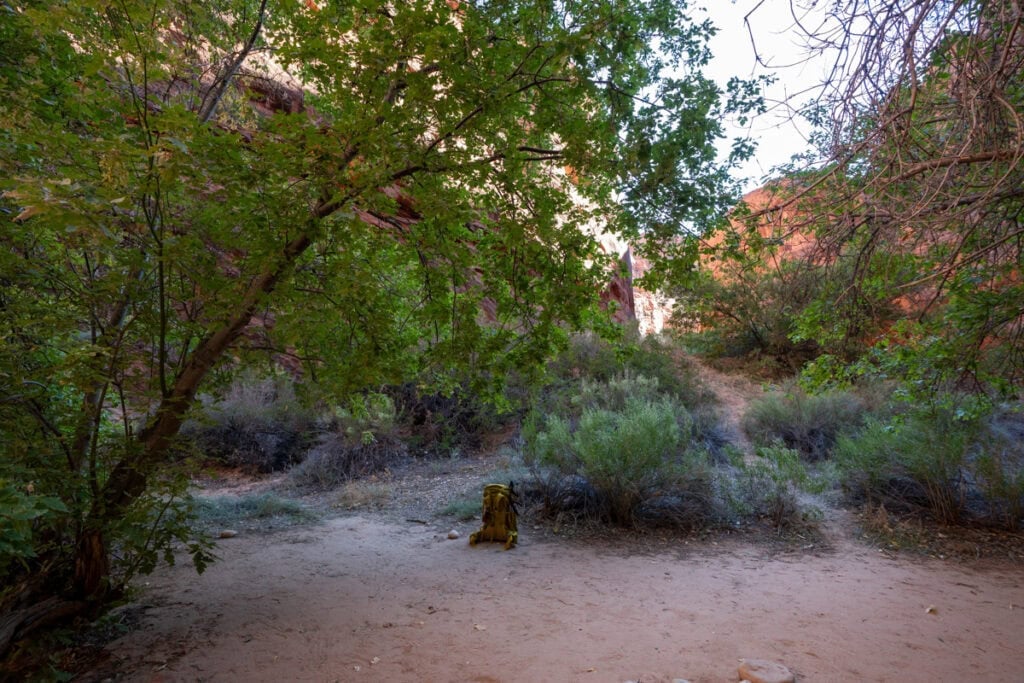

Day 2
Day 2 felt very long for us. An hour after leaving camp, we reached Big Spring at mile 12 – the first reliable freshwater spring. As mentioned above, most people prefer to get their drinking water straight from these springs rather than filtering from the river, but it’s always a good idea to have a backup water filtration method in case you miss a spring or it’s not flowing while you’re there.
At Mile 13, the canyon chokes up again, with a very similar feel to the Narrows section.
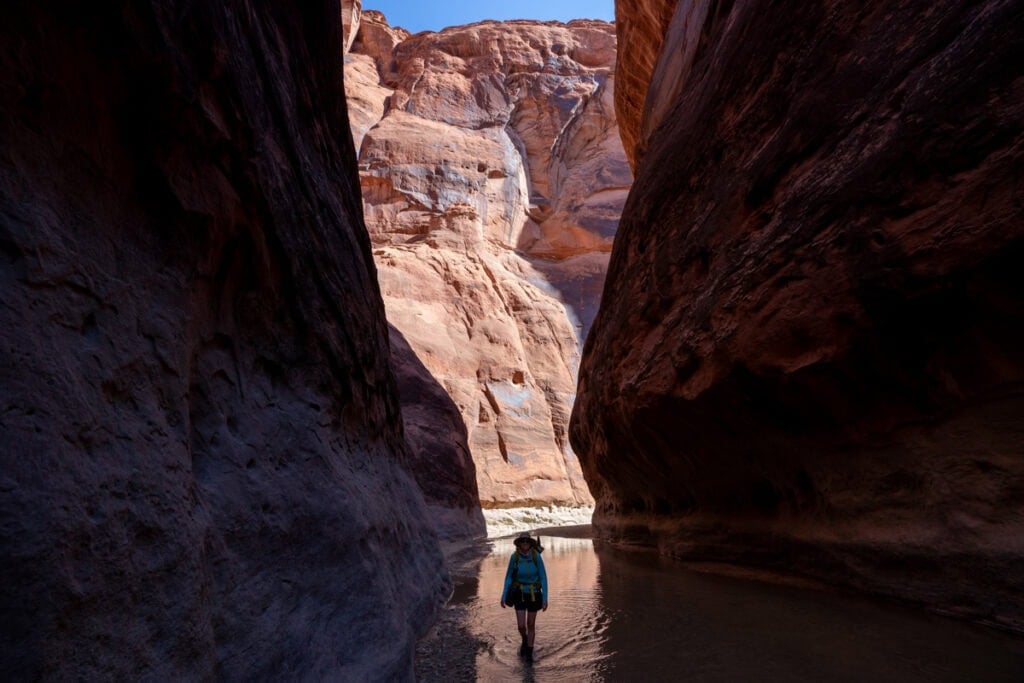
Around mile 15, there are a series of cave-like amphitheaters that rise 650 feet above the riverbed. This was my favorite part of day 2. There are tons of beaches to stop and relax on, so make sure to take your time and enjoy it.
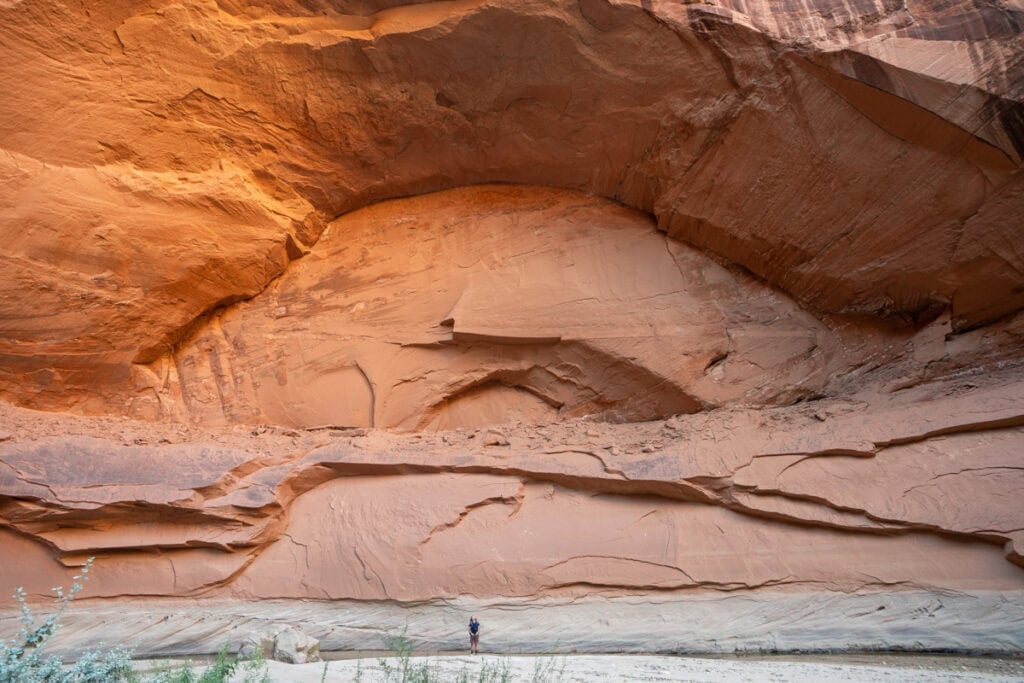
Once we reached Judd Canyon, we started to look for campsites. We couldn’t find the first site that was marked on the map around mile 18 that the ranger provided, so we kept going. At mile 19, we saw a faint trail up from the river on the left side that led to a flat campsite. We were tired, so we stopped, even though the campsite wasn’t that great. It was far from the river which made going pee a pain (unlike most trails, here you’re actually supposed to pee in the river).
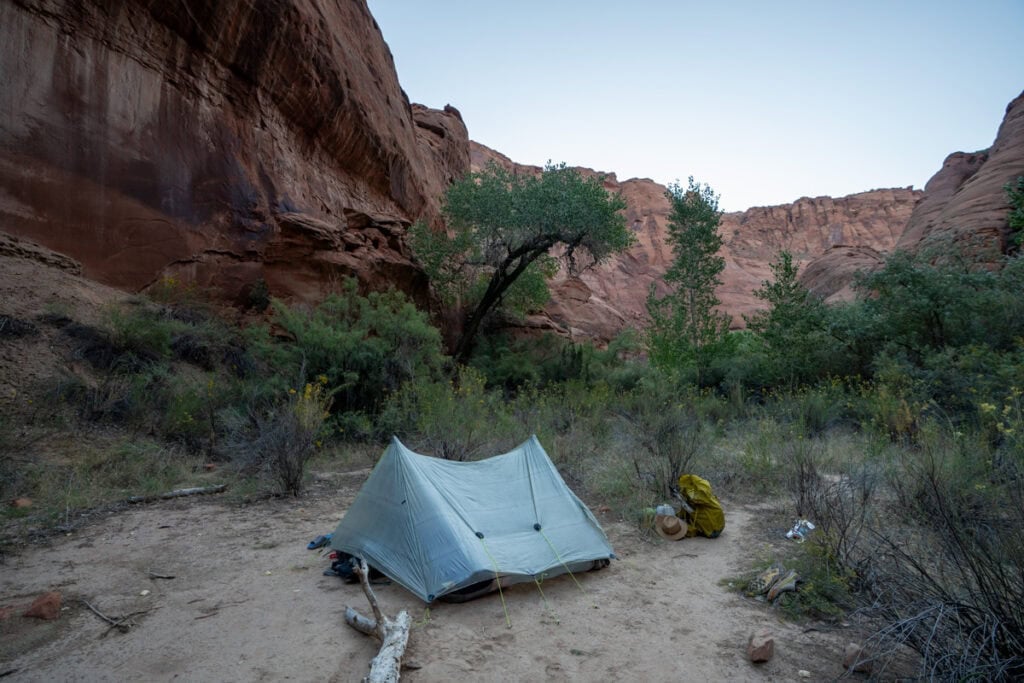
If you have more steam, I suggest continuing past here to the junction with Wrather Canyon. There is a nice site near the mouth of Wrather Canyon with better views and water access. There is also an optional 25-minute side trail up Wrather Canyon that leads to Wrather Arch. We didn’t do this, but I’ve heard it’s quite impressive. No camping is allowed up Wrather Canyon.

Day 3
On Day 3 the terrain began to change – the canyon broadened, but the river features got more interesting with rocky obstacles, deep holes, and small cascades. It was really neat to watch the canyon slowly transform over the course of the trip.
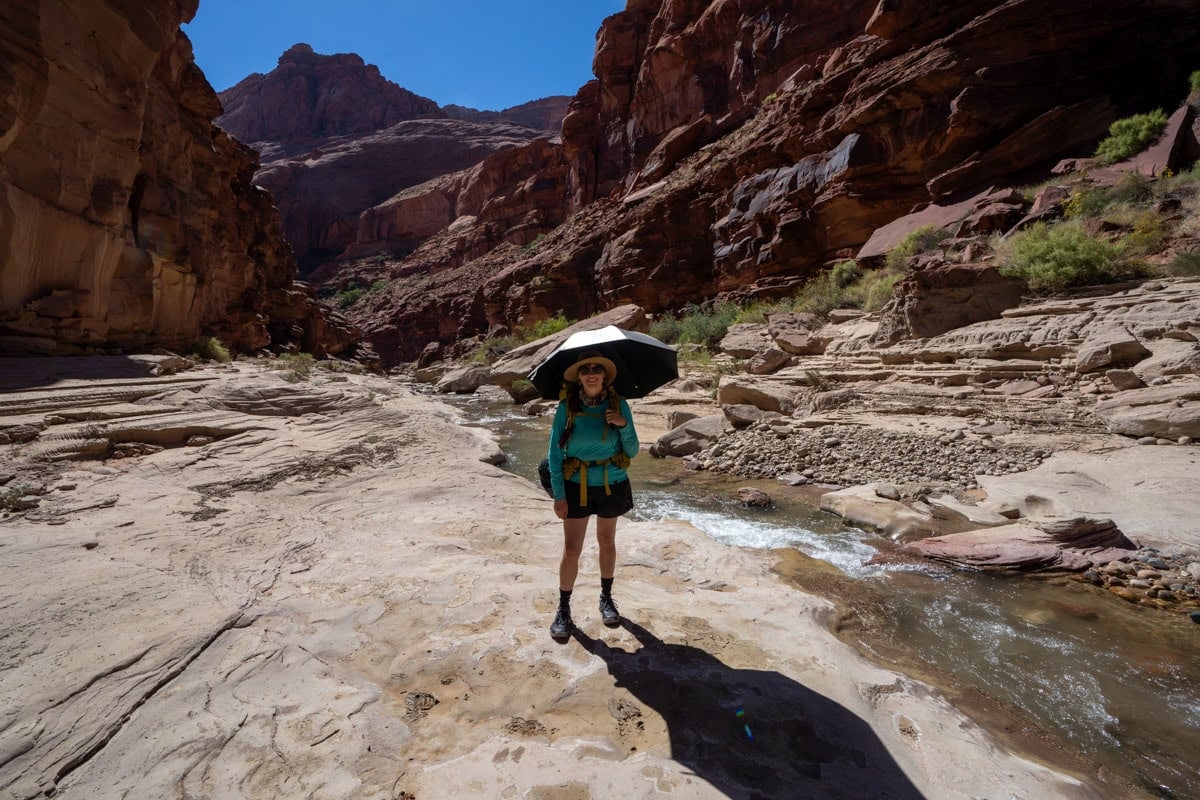
I found this day to be the most challenging. The pools in the river were deeper, which meant we had to scramble over rocks and boulders along the river’s banks. There was also less shade, which made it pretty exhausting.

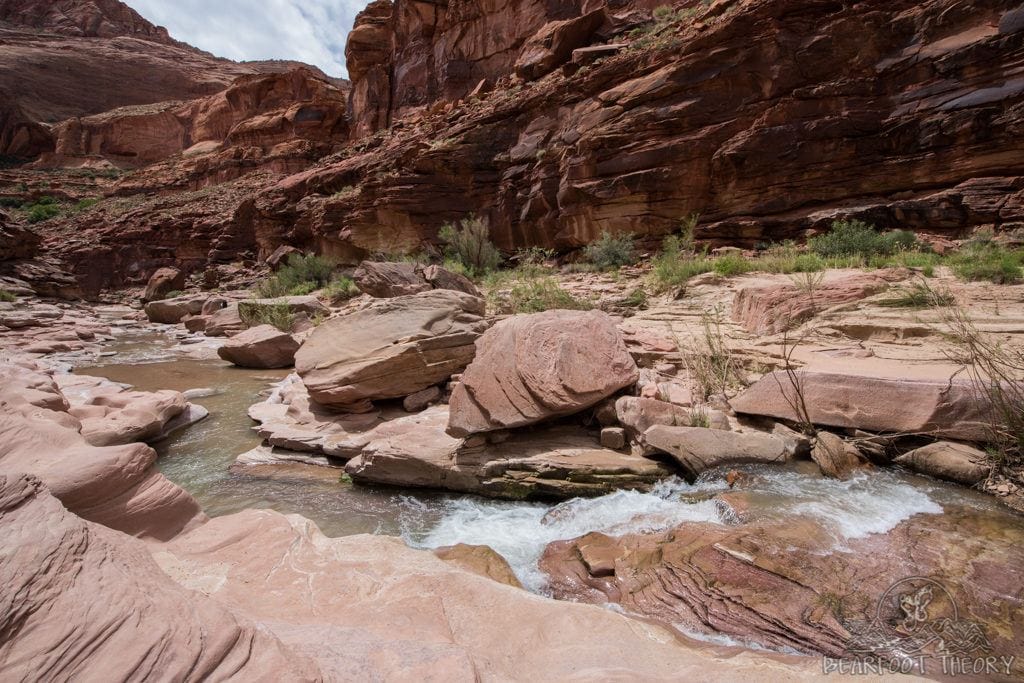
Many people choose to camp at the last reliable spring at mile 25, but that leaves 13.5 miles for the final day. That didn’t sound too appealing to us, so we filled up at the spring and kept going.
On both of my trips, we camped at the last good spot on the river, around mile 28. There’s an awesome spot on a high bank on the right side of the river with a perfect sunset view.
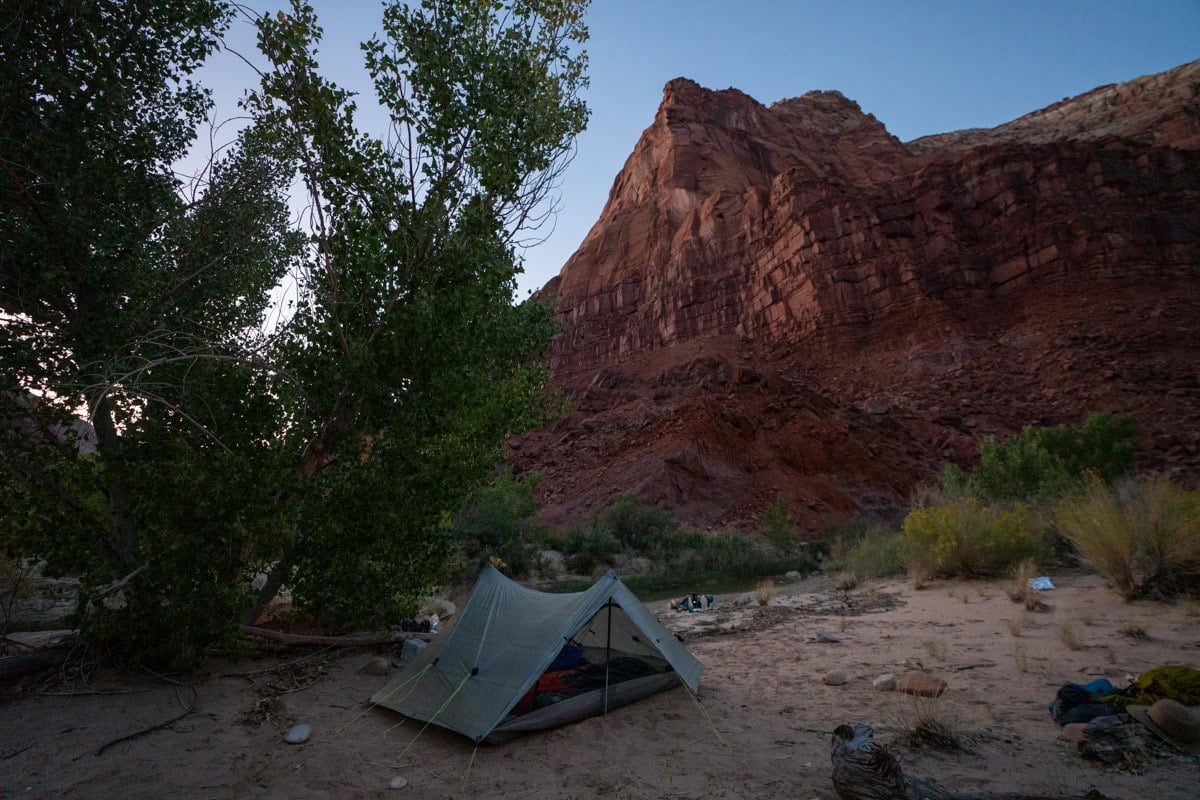
Day 4
The final day the landscape takes on more of a desert feel. The trail is hotter, drier, and sandier and with the canyon broadening, sun exposure can be intense so be sure to pack sun protection. That said, the views on the descent to Lee’s Ferry were gorgeous, and the variety in the scenery kept things interesting.
When we departed camp, there is an obvious trail that goes up and over the bench. It goes away from the river and looked like a shortcut, so we decided to follow it. We didn’t realize that this trail would take us far away from the water, not meeting back up with the river for 1.5 miles.
There were two sketchy sections. One where the trail was very narrow and exposed and a second steep rocky section. It wasn’t anything impassible, but these sections got my heart pumping. I’m not sure what it would have been like had we stayed in the river bed, so I can’t compare your options.
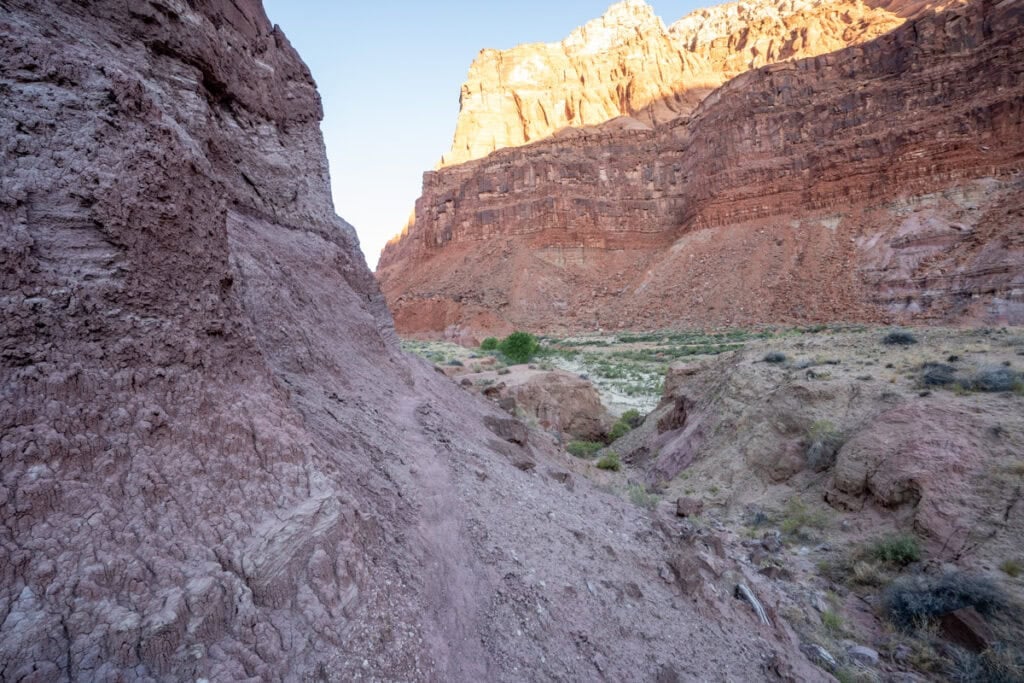
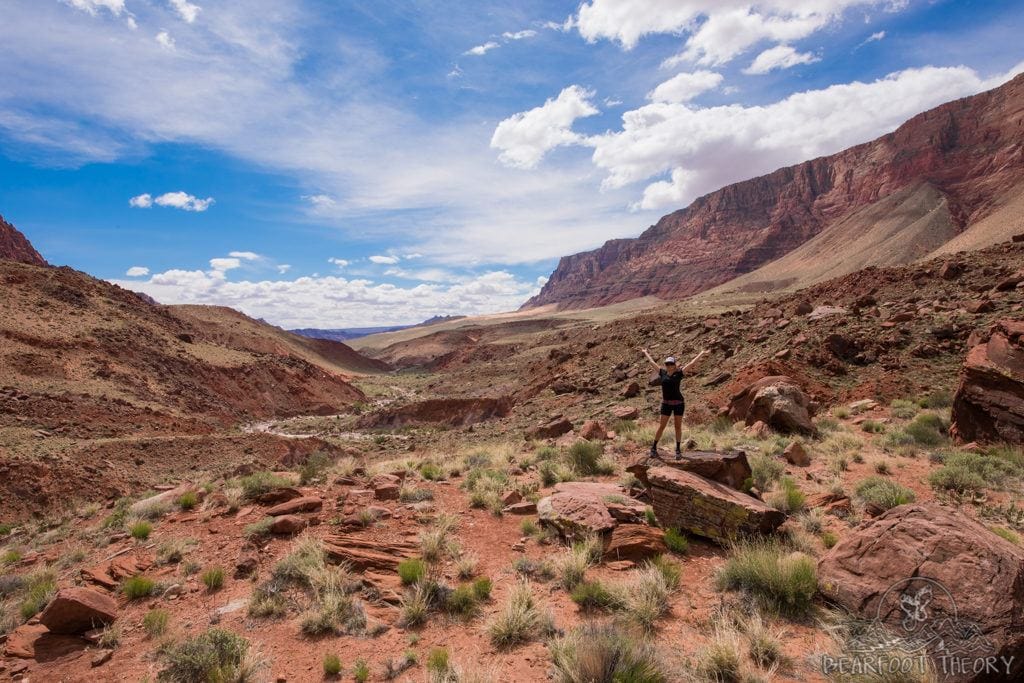
Eventually the trail met the river again. While the trail does cross the river a few times over the last several miles, most of your time is spent out of the water following a trail that crosses the river benches. It’s suprisingly slow going because the trail was often hard to track. Eventually, you come to an old ranch, indicating that you are close to the trail’s end at Lee’s Ferry.

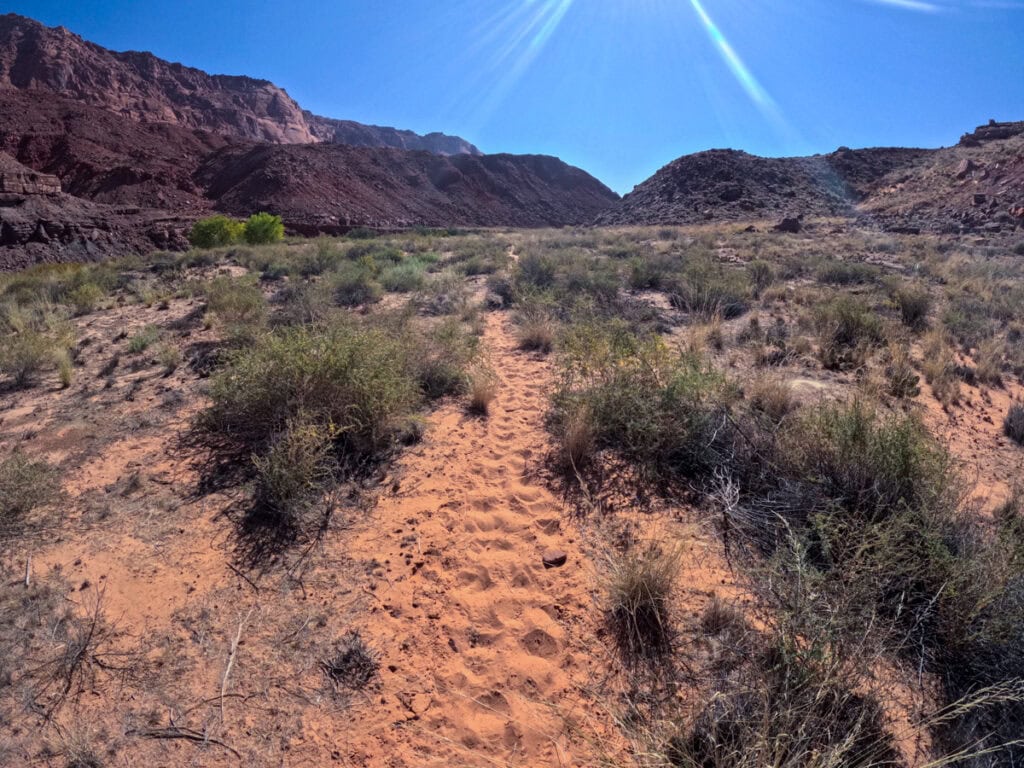
Gear for Hiking Paria Canyon
Start with this backpacking checklist and desert hiking clothes guide to pack for Paria Canyon. In addition to a map and your normal backpacking essentials, there are a few extra gear considerations for canyon hiking.
Hiking Shoes and Socks
The Paria River is cold and full of pebbles so I would not recommend water sandals for this hike. Instead, you’ll want to wear tennis shoes or a pair of lightweight, non-waterproof hiking shoes with a closed-toe and closed-heel. Waterproof hiking shoes will fill up with water while non-waterproof ones will allow water to go in and out. I wore my Oboz Katabatic (non-waterproof version) and fond them to be a great option for this hike.
Instead of regular socks, I highly recommend pairing your shoes with some 0.5 mm neoprene socks. These will prevent the sand and rocks from rubbing your skin and will help prevent blisters.
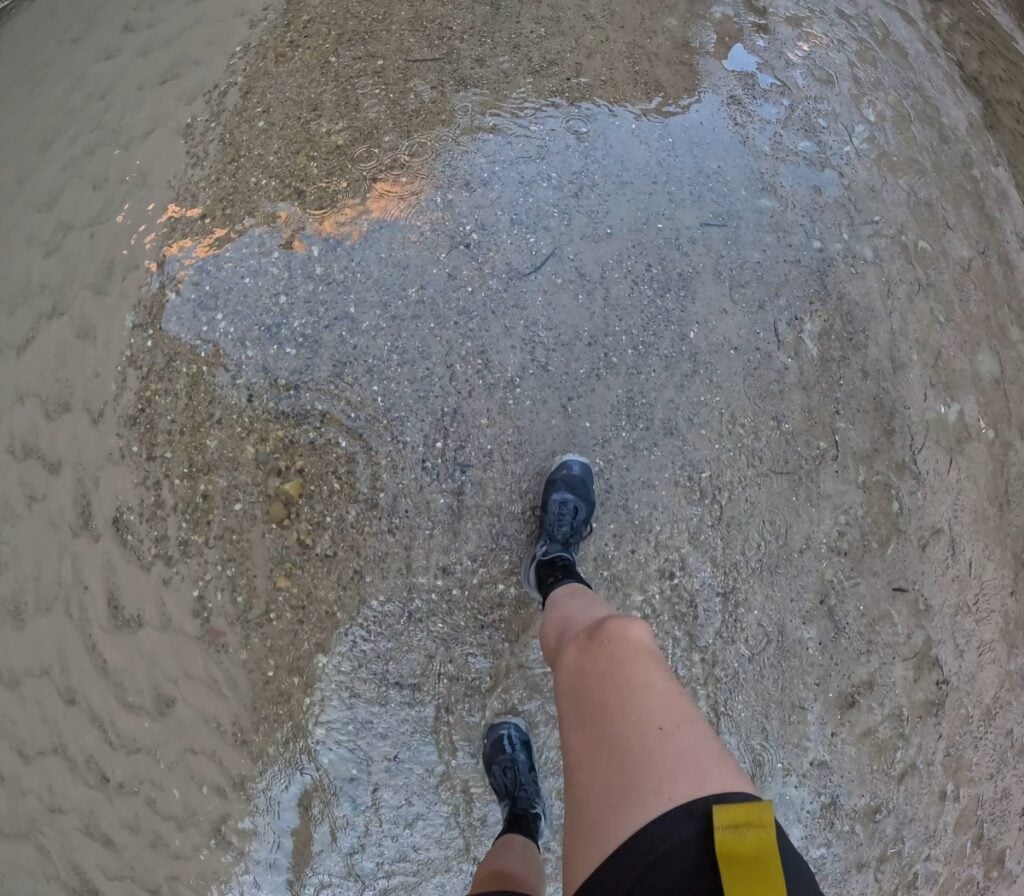
Dry Bags
On my trip, the water was never more than knee-deep, but the river can be waist-deep after periods of heavy rain. In order to keep your essentials dry, you might consider packing your sleeping bag, clothes, and electronics inside some lightweight dry bags. Or for a cheaper solution, you could line the inside of your pack with a garbage bag and then pack all of your gear inside of that.
Trekking Poles
I actually didn’t use my trekking poles much on this hike because I was using my hands to hold my sun umbrella instead. The trail is mostly flat, and there were sections I liked having my hands free. However, they can help with stability during the deeper river crossings, and I also use a tarp-style tent called the Zpacks that requires trekking poles to set up. If you do bring trekking poles, bring ones that collapse so you can throw them in your pack if you aren’t using them.
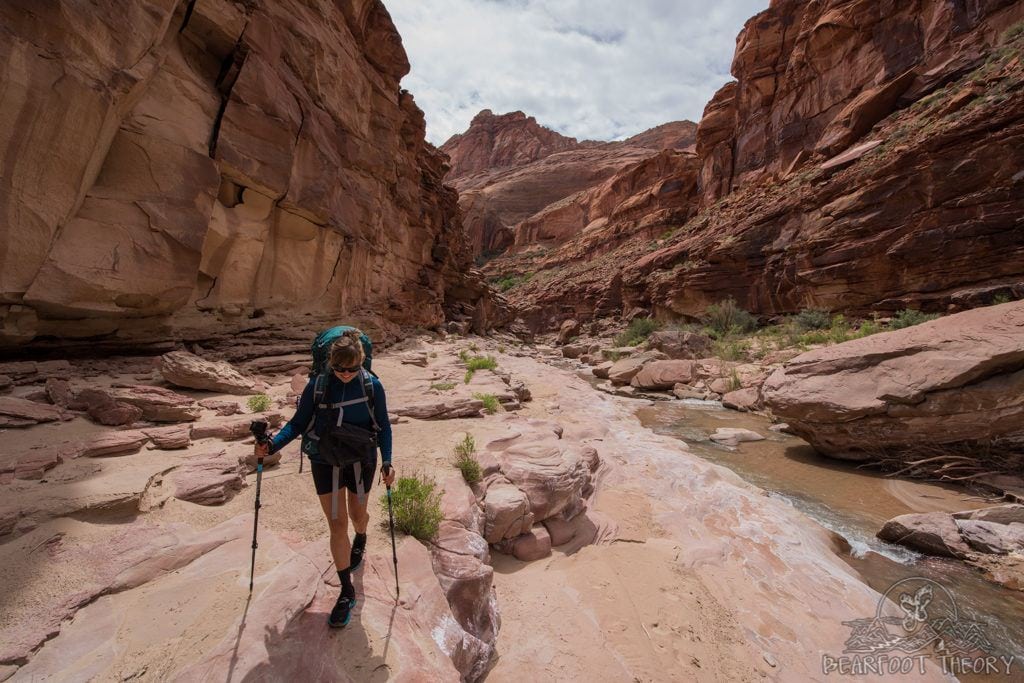
Sun Umbrella
This was the winning piece of gear on my most recent Paria Canyon hike. Even in late September, it was nearly 100 degrees and sunny the entire time. This Six Moons Designs sun umbrella is lightweight and reduces the temperature you feel by at least 10 degrees. It also reduces the amount of of sunscreen you need to reapply during the day.
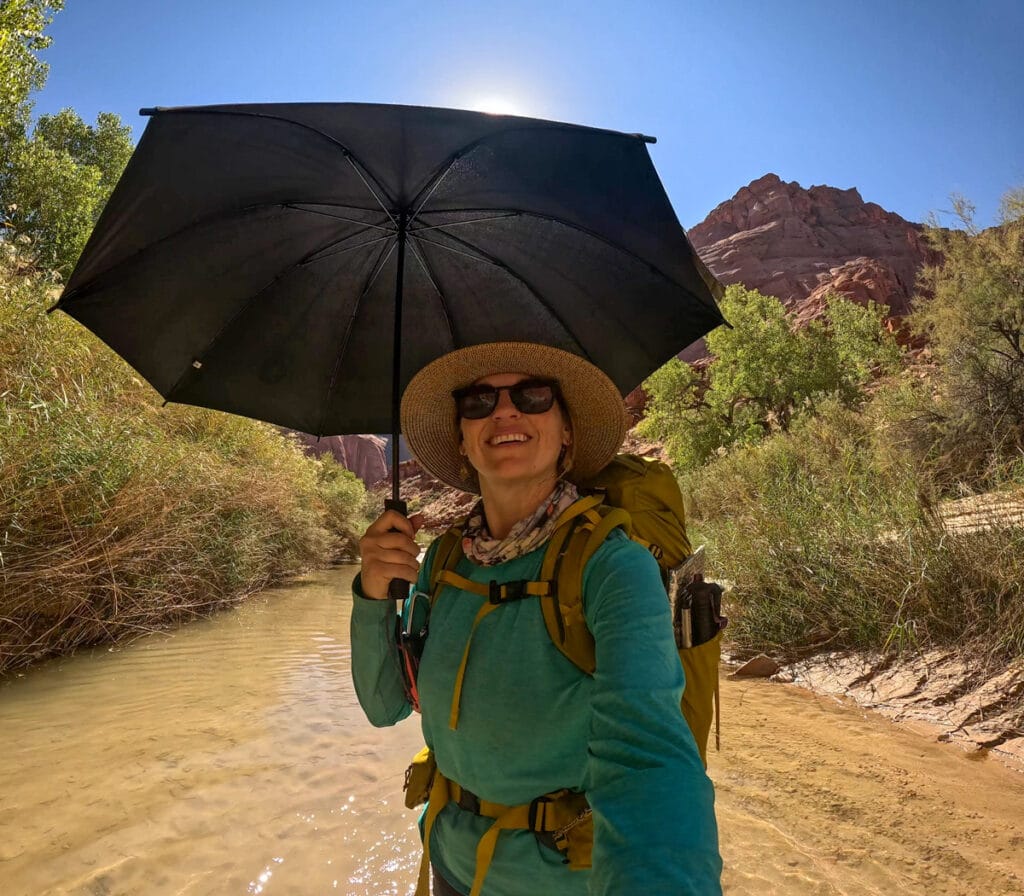
Water Filtration System and Bottles
Water Filtration
I brought the Versa Flow Lightweight water filter on my most recent trip because I heard it was very good at handling water with a lot of sediment in it. You can also backflush it easily if the slow fIows due to clogging. It performed very well and is much lighter than the Playtpus GravityWorks filter that I’ve been using for the lat decade.
I paired it with the CNOC Outdoors 2 liter water container. The wide opening made it very easy to fill from the river or springs, and it conveniently attaches to the Versa Flow filter. Then you either squeeze the water through the filter or you can hang it up and let gravity do the work.
Water Purification
There are a couple of options for purification, and it’s always good to bring these as a backup. The cheapest, lightest, and easiest are purification tablets.
Another (more expensive) option is the SteriPen. Just swirl the tip of the pen around in your water bottle for a minute, and it kills any viruses that might be present. The only thing about the SteriPen is it works best with wide-mouth water bottles, like a Nalgene, and it also runs on a rechargeable battery. This means you need to charge it up before you leave the house or bring along a battery pack or small solar panel to charge it in the field.
Water Bottles/Reservoirs
If you’re planning on filling up in the springs, I would recommend carrying a 3L hydration reservoir, as well as a few extra lightweight water bottles. Having the capacity to carry extra water will provide you more flexibility in where you can camp.
Shuttle Info
Because this is a one-way hike, you will need to do a car shuttle so you aren’t stranded when you reach the end. If you have two cars, that makes it very easy.
If you have to shuttle cars, you should drop off one car at Lee’s Ferry the day before your hike. Then you can drive to White House where there is a first-serve campground with a pit toilet, picnic tables, and fire rings. that night. Camping here means you can get an early start the next morning.
If you don’t want to camp, there are a lot of hotels in Page, which is about 25 minutes from the White House Trailhead.
If you’re parking a car at White House, they will give you a parking tag when you pick up your permit at the Contact Station. Make sure to leave this on the dashboard of your car.
Drinking water and trash disposal are available at the Paria Contact Station at the northern end of the campground access road – I recommend filling up your water here before starting the trail.
If you don’t have two cars, there are several companies you can hire to shuttle you. We used Grand Staircase Discovery Tours which was $200 total. They met us at Lee’s Ferry at 7:30 am the morning of our hike. We gathered all of our gear, dropped our off car, and then they drove us up to the White House trailhead. This was great because our car was there waiting when we finished the hike.
There are other companies, but some of them charge per person, so you’ll want to compare pricing before you book.
Leave No Trace
Here are a couple of things to keep in mind for Leaving No Trace and reducing your environmental impact in Paria Canyon.

Frequently Asked Questions
Techincally yes. Dogs are allowed in Paria Canyon. It costs $5 per dog per day, and you are required to pack out their poop. However from a practical standpoint, I don’t think this is a very dog-friendly trail, and I personally wouldn’t bring my dogs. You’ll want to filter the water for your dogs so they don’t get sick. There are also lots of cactus and pokey things that could hurt their paws. Finally if the water is deep, it could create challenges for them.
You can day hike through the Paria Narrows without an advanced permit. However, from the White House Trailhead to the confluence and back is 14 miles round trip, with more than half of that in a dry river bed in the full sun. If you are doing a day hike, I suggest doing Wire Pass to Buckskin Gulch instead and saving Paria Canyon for a backpacking trip.
Most people hike from White House to Lee’s Ferry. In this direction, the trail gently slopes downhill and you are hiking with the flow of the river. The most convenient place to pick up your permit is also the Paria Contact Station which is right next to the White House Trailhead. However, there is no reason you can’t hike from Lee’s Ferry to White House instead if that is more convenient.
Backpacking Paria Canyon was my favorite desert trip to date, and with the colorful scenery and lack of crowds, Paria Canyon will not disappoint!
Have you backpacked the Paria Canyon in Utah or plan to?
Let us know in the comments!

